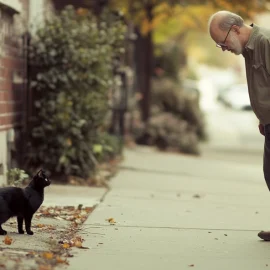

This article is an excerpt from the Shortform book guide to "Polysecure" by Jessica Fern. Shortform has the world's best summaries and analyses of books you should be reading.
Like this article? Sign up for a free trial here.
What role does attachment theory play in building polyamorous relationships? How can understanding your attachment style help you navigate multiple partnerships?
In Polysecure, Jessica Fern discusses the evolution of attachment theory. Polyamory can be supported by modern interpretations of attachment theory that offer fresh perspectives on building secure bonds across various relationship structures.
Keep reading to discover how attachment theory is being reinterpreted to accommodate consensual non-monogamy.
Attachment Theory & Polyamory
In her book, Fern offers advice on how you can have polyamorous relationships rooted in secure attachment with yourself and your partners. Specifically, if you understand and apply attachment theory, polyamory can become more fulfilling.
While consensual non-monogamy (CNM) might be a good option for some, it comes with a unique set of challenges, such as managing jealousy, changing relationships dynamics, and maintaining clear and open communication among all partners. Fern says that understanding your attachment style and working to build secure attachment will help you navigate the complexities of CNM.
(Shortform note: While Fern focuses on the importance of understanding your attachment style in navigating CNM, Louisa Leontiades, author of The Husband Swap, emphasizes the value of personal experience. Leontiades draws from her own journey through open marriages and polyamorous relationships to offer practical advice on managing time, societal judgments, and conflicts. She underscores the importance of adaptability and resilience, suggesting that learning from real-life scenarios is most essential for a successful CNM experience.)
We’ll begin with an overview of standard attachment theory and outline the four attachment styles. Then, we’ll explain the problem with traditional attachment theory and how an updated understanding of attachment fits in with CNM.
What Is Attachment Theory?
Attachment theory, based on the work of psychologist John Bowlby, proposes that the quality of our early interactions with our caregiver (or caregivers) directly influences whether we develop a secure or insecure attachment that we often carry with us into adult relationships.
(Shortform note: When Bowlby first introduced attachment theory in the mid-20th century, he faced significant criticism from both academic psychologists and psychoanalysts. Critics argued that Bowlby’s reliance on observational evidence lacked scientific rigor. Additionally, his focus on a single preferred caregiver, typically the mother, was seen as overly simplistic. Many traditional psychoanalysts were especially skeptical, as Bowlby’s focus on real-life mother-child interactions deviated from the then-dominant emphasis on unconscious drives and internal fantasies popularized by Sigmund Freud. Attachment theory still has critics today, some of whom question its clinical application.)
Fern explains that, according to attachment theory, children who receive consistent nurturing care that responds to their needs typically develop secure attachments. This generally results in healthier, more open relationship dynamics as adults. In contrast, children who experience neglect or inconsistent responses from caregivers are more likely to develop insecure attachments, which, Fern adds, can often lead to challenges forming or sustaining intimate relationships later in life.
(Shortform note: Neuroscience research confirms that our early experiences with caregivers have a profound effect on brain development. However, Daniel J. Siegel, in The Developing Mind, emphasizes that the brain’s inherent neuroplasticity—the capacity to adapt and form new neural connections—offers a path to healing. Even those who begin life with insecure attachments, marked by inconsistent care, have the potential for significant emotional and psychological growth. Siegel argues that through interventions like therapy, someone with insecure attachment can develop healthier patterns of brain activity, enabling them to overcome early adversities.)
Trauma, experiences that cause significant psychological distress, such as abuse or neglect, can disrupt people’s ability to form secure attachments. Trauma can manifest in behavior patterns such as heightened anxiety, avoidant tendencies, or difficulty trusting others. Fern argues that understanding and addressing these trauma-related attachment issues is especially important in non-monogamous relationship models like CNM.
(Shortform note: Polyvagal theory, developed by Stephen Porges, offers a biological explanation of how trauma affects our nervous system’s ability to engage socially. The theory categorizes the autonomic nervous system (the system that controls involuntary processes) into three parts: sympathetic (fight or flight), parasympathetic (rest and digest), and a social engagement system that influences our interactions. Trauma can keep you in a perpetual state of fight or flight, impairing your capacity to trust and connect with others. This can be particularly challenging in CNM relationships in which you’re navigating multiple emotional connections.)
The Four Attachment Styles
According to attachment theory, there are four attachment styles: secure attachment, and three types of insecure attachment (anxious, avoidant, and disorganized).
1) Secure Attachment: People with a secure attachment style are typically comfortable with intimacy and are also able to seek out and provide support when needed. They tend to have stable and trusting relationships.
2) Anxious Attachment: Those with an anxious attachment style often fear abandonment and may exhibit strong emotional reactions and a high need for closeness that can sometimes overwhelm their partners. They might seek out multiple partners or casual sex to gain validation and reassurance, as they often fear abandonment and crave constant attention.
3) Avoidant Attachment: People with an avoidant attachment style may seem emotionally distant or uninterested in close relationships. They often maintain their independence and withdraw from displaying affection or fully engaging in a relationship. They might prefer keeping relationships superficial and engaging in casual sex to maintain their independence and avoid the vulnerability that comes with deep emotional connections.
4) Disorganized Attachment: This style is characterized by inconsistent behaviors that can confuse partners, stemming from a mix of avoidance and anxiety regarding attachments. People with disorganized attachment might find it hard to trust others, feel insecure about their relationships, or struggle to regulate their emotions.
(Shortform note: Mary Ainsworth’s research, which built on Bowlby’s earlier work in attachment theory, was pivotal in developing the four attachment styles. Through her “Strange Situation” study in the 1970s, Ainsworth observed how infants responded to brief separations and reunions with their caregivers. These observations led to the identification of secure, avoidant, and ambivalent attachment styles. Later researchers added a fourth style, disorganized attachment, based on further studies. Ainsworth’s work provided the empirical backbone for Bowlby’s theoretical constructs, cementing attachment theory’s central role in understanding child development.)
The Problem With Traditional Attachment Theory
According to Fern, traditional attachment theory often privileges monogamy by assuming that a secure attachment is typically formed between two individuals, mirroring the conventional monogamous relationship structure. She argues this narrow focus overlooks the possibility that secure attachments can also be formed within non-monogamous contexts where people have multiple close, nurturing relationships. Fern contends that attachment theory can be expanded to include these diverse relationship models, emphasizing that secure attachments are about the quality of care and emotional responsiveness, regardless of the number or configuration of relationships.
(Shortform note: Traditional attachment theory does make room for the possibility of multiple secure attachments. While Bowlby’s initial research focused on the infant-caregiver relationship, attachment theory recognizes that adults typically form secure attachments with multiple people, such as romantic partners, close friends, and family members, all of whom contribute to an individual’s overall sense of security and well-being.)
Fern says that, according to studies, people in non-monogamous relationships often achieve levels of secure attachment comparable to, or even greater than, those in monogamous partnerships, challenging the belief that insecurity or instability is inherent to non-monogamy. Likewise, engaging in casual sex or having multiple sexual partners aren’t symptoms of insecure attachment. Fern argues that this belief unfairly stigmatizes CNM relationships by not acknowledging that people can engage in casual sex or multiple relationships from a place of security and personal satisfaction rather than insecurity.
(Shortform note: Research suggests that in societies where CNM is less stigmatized, people will likely find it easier to form healthy attachments with multiple partners. Acceptance and supportive communities reduce stress and provide validation, fostering healthier relationships. Positive cultural narratives and legal recognition further legitimize CNM, promoting stability and predictability in the relationship. In contrast, stigma and marginalization in less accepting societies can create stress and hinder secure bonds.)
How Attachment Theory Has Evolved
Fern emphasizes that you can cultivate secure attachment through mutual respect and care, regardless of your relationship structure. She thus offers two advanced frameworks of attachment theory that are more in line with polyamorous relationships: the two-dimensional model of attachment and the nested model of attachment.
(Shortform note: While Fern expands on the two-dimensional and nested models, there are other attachment models such as the Dynamic Maturational Model (DMM) of attachment that also merit attention. The DMM highlights how individuals adapt their attachment behaviors based on environmental and developmental influences, emphasizing the fluid—rather than fixed—nature of attachment.)
The Two-Dimensional Model of Attachment
Unlike Bowlby’s four attachment styles, the two-dimensional model of attachment assesses people’s attachment behaviors by evaluating their levels of anxiety—worry about their partner’s availability and fear of abandonment—and avoidance—the extent to which they maintain emotional distance and rely on themselves rather than seeking closeness with others.
This model expands on the original categories of secure, anxious, avoidant, and disorganized by showing that these behaviors aren’t static and can change over time, across different relationships and different contexts. Therefore, Fern argues, this model is particularly pertinent in polyamorous relationships, where multiple emotional connections can trigger varying levels of anxiety and avoidance within each unique relationship dynamic. For example, if someone feels secure with partner A but becomes anxious when partner B starts dating someone new, it illustrates how attachment styles can shift depending on the specific relationship and situation.
(Shortform note: To enhance the understanding of adult attachment, Kim Bartholomew and Leonard Horowitz designed the two-dimensional model of attachment. They aimed to expand beyond traditional models that focused mainly on a single axis of security versus insecurity. By analyzing how individuals perceive themselves and others, they identified two key dimensions—Model of Self and Model of Others. These dimensions intersect to form four distinct attachment styles. Their method involved integrating findings from studies on self-esteem, social competence, and interpersonal trust with classical attachment theory, creating a richer framework for analyzing adult relationships.)
The Nested Model of Attachment
Expanding on Bowlby’s original theory, the nested model of attachment highlights how your attachment style is impacted by more than just your family of origin and is instead also shaped by wider social, cultural, economic, and environmental factors.
Fern argues that by recognizing multilayered influences, the nested model of attachment allows a more comprehensive approach to understanding and addressing the complexities of individual attachment styles. Within this model, attachment security is influenced not only by individual relationships but also by the surrounding network, including partners, metamours (partners’ partners), and even broader community contexts. By acknowledging these interconnected layers, Fern explains, the nested model offers a holistic understanding of fostering secure attachments in polyamorous or non-monogamous settings.
(Shortform note: The nested model of attachment evolved through decades of research, heavily influenced by Bronfenbrenner’s Ecological Systems Theory from the 1970s. Bronfenbrenner’s theory introduced the idea that human development is affected by multiple, nested environmental layers, including immediate environments (microsystem), interactions between these environments (mesosystem), indirect influences (exosystem), broader cultural and societal contexts (macrosystem), and changes over time (chronosystem). This framework expanded attachment theory beyond early caregiving to include wider social, cultural, economic, and environmental factors.)
Exercise: Identify Your Attachment Style
Fern argues that understanding your attachment style is crucial in the context of polyamory, as it helps you navigate multiple relationships more effectively, ensuring everyone involved feels secure and valued. By recognizing your patterns and reactions, you can better manage potential issues such as jealousy, insecurity, and unequal attention, all common complex dynamics within polyamorous relationships.
- Recall your past and present relationships. Based on your behavior patterns, identify your predominant attachment style: secure, anxious, avoidant, or disorganized.To identify your attachment style, assess your typical behavior in relationships: Do you have a healthy balance of closeness and independence without major fears or anxiety (Secure)? Do you often worry that you’ll be abandoned and feel you need more from your partner (Anxious)? Do you tend to avoid closeness and feel uncomfortable sharing emotions or supporting your partner during tough times (Avoidant)? Do you have mixed feelings about intimacy, sometimes desiring it and at other times feeling scared or uncomfortable (Disorganized)?
- Think about one specific moment when you believe your attachment style influenced your actions or reactions. What happened? How did you respond?
- How would you have responded differently if you were polysecure, or had more secure attachment in that relationship?

———End of Preview———
Like what you just read? Read the rest of the world's best book summary and analysis of Jessica Fern's "Polysecure" at Shortform.
Here's what you'll find in our full Polysecure summary:
- How to feel secure in a multiple-partner relationship
- Why the traditional attachment theory only works for monogamy
- The unique challenges of consensual non-monogamy






